Top Tools to Help You Learn Chinese Pronunciation and Pinyin
How do you know how to pronounce Chinese characters? They don’t have any reliable way to know this by looking at them. Enter the hànyǔ pīnyīn (汉语拼音) alphabet, a phonetic system used in all schools in mainland China, as well as by the majority of people learning Chinese as a second language around the world.
The pīnyīn alphabet looks the same as the European, or “Roman,” alphabet – hence the term “romanization.” It offers a way to write out the phonetic sound of a Chinese character, and you may have already run across it in textbooks or on signs. Not all of the letters are pronounced as they would be in English, so watch out for “false friends” like “c,” “z” and “r” and make sure you master these sounds with regular practice. Also, take note that sometimes “v” is substituted for “ü”.
Another challenge for second-language learners is that Mandarin Chinese (pǔtōnghuà, 普通话)is also a tonal language, with four distinct tones (shēng, 声) : high (1), rising (2), low (3), falling (4); there are also some syllables that are toneless.
Tones are either indicated by marks above the syllables (bā, bá, bǎ, bà, ba) or numbers (ba1, ba2, ba3, ba4, ba). Generally, the fifth tone in pīnyīn isn’t written out.
To guide you on your path to mastering Chinese tones and pronunciation, we’ve compiled a list of useful strategies and Chinese pronunciation tools to help you see real improvement in your Chinese speaking skills no matter what level you’re at!
Your Chinese Pinyin Toolkit
#1: Four Tones Chart
As mentioned earlier, there are four different tones used in Mandarin Chinese. Tones are used to distinguish words that have the same sound. They may sound similar to speaking with intonation in English, except rather than conveying emotion, they convey a different meaning. Below is a chart of the different tones used (Clickable in “Pinyin” column).
#2: Mandarin Chinese Pinyin Chart with Audio
Here you can see Chinese pinyin chart with audio examples.
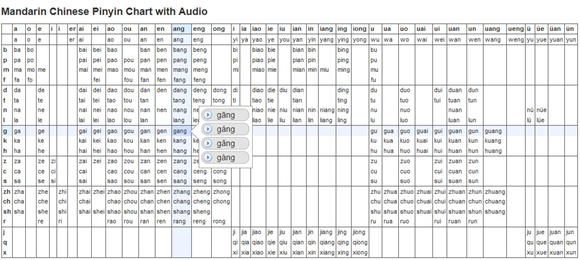
Dong Chinese also offers an audio database of pinyin sounds as part of its initial 10-lesson free course. At the end, there is a test where you can practice speaking with sentences provided in pinyin, Chinese characters and English. As the image shows, you get a grade for each section and are able to hear a recording of how you sounded. The course is also graded as a whole.
#3: Numeric Pinyin to Tone Marks Converter
Presenting the Pinyin Convert Tool – you can use numbers to add tone marks to pinyin. For example, if you type “Xi1an1,” it will be converted to “Xī’ān.” This is helpful when you want to type in pinyin using tone marks.

As the creator of the website says, “This Chinese numbers pinyin converter tool is the first and only tool for correctly adding tone marks to pinyin from within a web browser. All of the other tools of this type that I’ve seen require server requests, and thus make the user wait during page loads.”
It’s certainly a good choice if you need to add tone marks without waiting around too long.
#4: Chinese Character to Pinyin Converter and Translator
This Chinese to pinyin conversion tool lets you input Chinese characters, which it will then transfer into pinyin alongside the meaning of the characters.
You can use it for Simplified Chinese or Traditional Chinese. This Chinese to pinyin translation tool can differentiate between characters that have multiple possible pronunciations.

Your Chinese Pronunciation Practice Toolkit
Language learning apps are a great way to study as they are designed to deliver bite-sized lessons that you can fit into a busy schedule and practice on your phone. You can also set daily reminders to do your language exercises. Many apps have free trial periods, so you can see if their teaching style is a good fit for you.
While websites like FluentU offer plenty of immersive video materials with subtitles, which have clickable audio elements to help with pronunciation, there are now quite a few apps that offer audio comparison or even electronic evaluation of your pronunciation, providing instant feedback on how you’re doing.
#1: Audio comparison apps
It’s not just character-learning that benefits from a daily training routine – now you can choose from a number of different apps that compare your pronunciation with an example recording or use text-to-speech to see how clearly you are pronouncing words in Chinese.
Speechling has an online flashcard learning system that allows you to compare audio of you reading out words and sentences with a recording from a native speaker. You are assigned a coach upon registration and can save your recordings for review and feedback by a human tutor.
There are several difficulty levels from Beginner to Expert, which makes this a useful tool for almost any learner — even people who already speak Chinese quite well but lack the opportunity to practice it.
You can give feedback on how hard or easy you found each flashcard, with the harder ones repeated more often.
Your coach – mine was located in Beijing, so be aware of a possible time difference – gets back to you within a day or so to give feedback, either by saying you did great or suggesting you keep working on a specific phrase.
I liked the fact that you can pick recordings of a woman or a man to compare with, as it’s hard sometimes to compare your voice with one that’s much higher or lower.
AccentLab’s Chinese pronunciation checker offers you the chance to record yourself saying vocabulary from HSK Levels 1-6 and to practice some of the tone pairs. This is important because sometimes the tones change when certain tones are paired together in a word.
The site uses a voice-to-text function to evaluate your pronunciation, telling you which pinyin and tones it heard you say.
It’s a fairly clunky interface which didn’t fit too neatly into the display of my small laptop, but it’s fast and efficient at giving feedback. I’d say it’s perfect to keep open in a browser tab to use on and off during the workday.
The Chinese Pronunciation Trainer on Google Chrome can be installed directly into your Chrome browser on any operating system. This trainer offers a fairly basic interface that fits into a pop-up window in your browser.
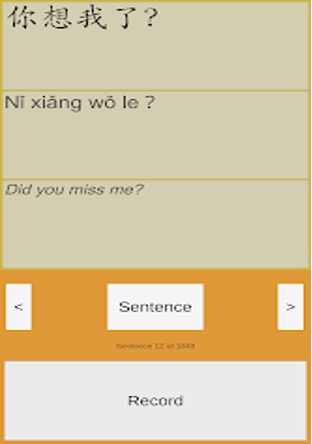
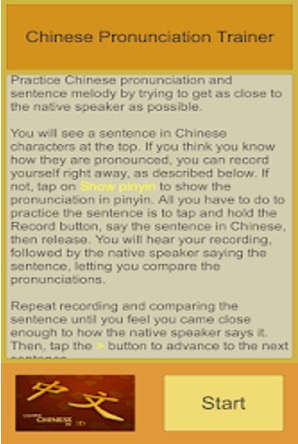
While you can’t select which vocabulary terms to practice as you can with the other two options, there are thousands of sentences, so it’s a fairly effective way to put in some daily practice if you prefer a simpler experience.
#2: The Shadowing Method
Shadowing is a simple yet effective way to practice speaking and listening at the same time. It involves listening to audio, then repeating what you hear almost immediately.
The method of both listening and following closely with speaking helps you hone in on key aspects of pronunciation. The idea is to imitate everything about the speaker’s delivery, including intonation, pitch, stress and even the emotion.
As well as giving your vocal cords and facial muscles a workout, the process is deeply engrossing and really helps to reset your brain’s expectations of what kind of sounds you should be making when you speak. It also builds confidence when used over time, so when you do speak, your listeners won’t have to work too hard to understand you, and your conversations will flow more easily.
It’s not unlike drama class — we are acting to some extent when we take on a new language, after all.
Here’s a sample from the first lesson, on the topic of hobbies (àihào, 爱好)
Step 1: Listen to the whole conversation or content first. Pay close attention to the marked words or phrases. Remember the pauses and intonation.
Step 2: Listen to the material sentence-by-sentence and repeat each sentence after listening to it. Try to imitate the pronunciation, the tone, the stress, and even the emotion. Please feel free to shadow each sentence again and again.
Step 3: Listen to the material as a whole and read with it at the same time. Try to make sure your sound matches perfectly with the audio. You can check out more free training lessons here.
#3: Clickable subtitles for Chinese dramas
Language Reactor is a fun language-learning extension currently available on Google Chrome. It can be used with both Netflix and YouTube. The extension provides subtitles for videos, and you can opt to have it show characters, pinyin or an English translation. When you hover your mouse over a character, it tells you the pinyin and the English for it. Clicking on the character allows you to hear the pronunciation and the English meaning.
Watching Chinese language shows with the Chinese subtitles on is a less intensive yet still effective listening practice that will also improve your pronunciation. Netflix has an impressive collection of dramas set in imperial times in majestic palaces with amazing period costumes, a particular favorite of mine. My personal recommendations are The Princess Weiyoung (锦绣未央; Jǐnxiù wèiyāng) (shown at the right being used with Language Reactor) and Yanxi Palace: Princess Adventures (金枝玉叶; Jīnzhīyùyè).
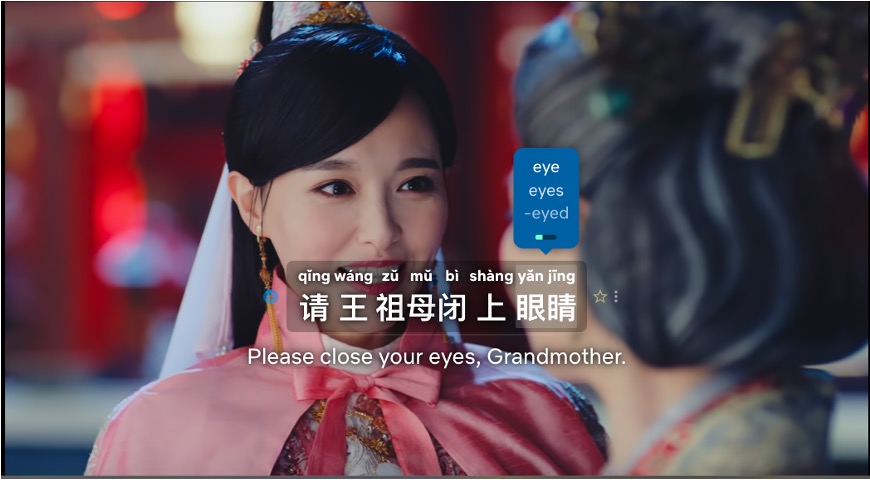
Important note: The dialogue seen in Netflix shows may be better suited to intermediate and advanced students than beginners.
#4: Language exchange partners
And of course there’s always the offline option – finding a language exchange partner who can correct your pronunciation and boost your confidence in speaking Chinese in real-life situations.
You can check out more tips about learning Chinese through the language exchange here.
From recording your speaking abilities to testing your tones, these Chinese pronunciation tools should help invigorate your interest in mastering Mandarin pronunciation. Remember to go at your own pace. There are so many resources that you can design your own study plan and learn with methods that suit you best. These apps and learning tools should prove useful no matter which stage of learning Chinese you’re currently at.
Finally, I’ll leave you with my top tip: put in some kind of speaking practice every day, even if it’s only for a few minutes. And be fearless! The more you speak when nobody’s listening, the better you will sound when they are.



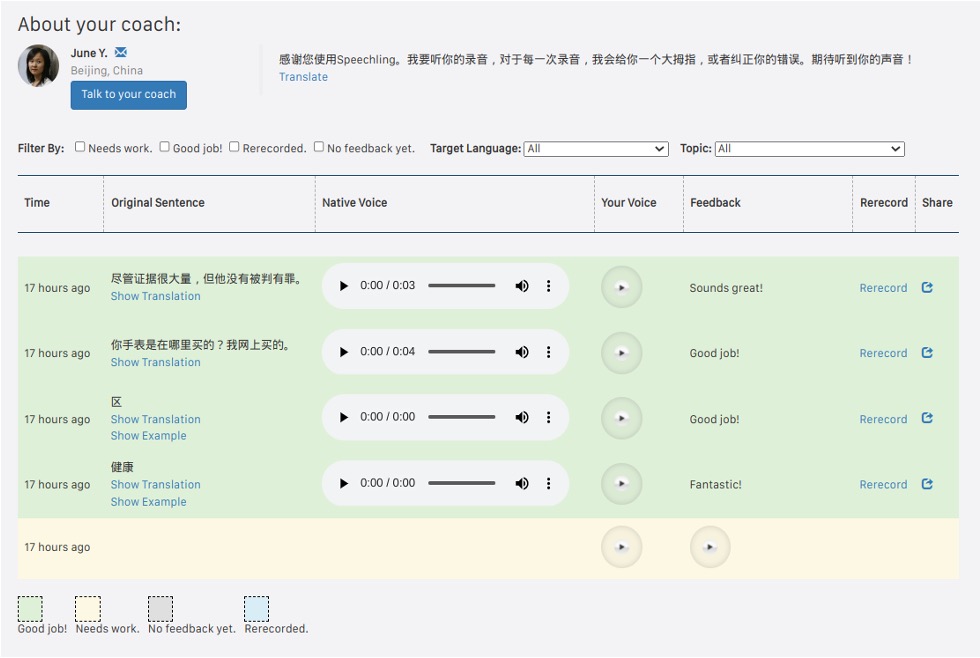
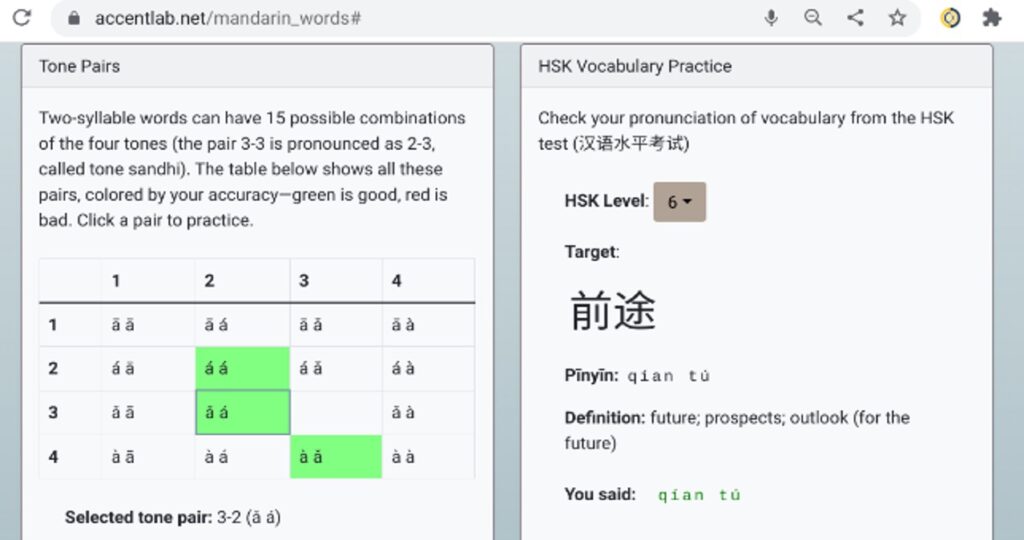




Thanks for sharing this wonderful post! Learning Chinese Pinyin system
is first step towards learning how to understand and pronounce Chinese
symbols. Correct pronunciation is one of the important aspects of
learning Chinese language. Wrong pronunciation deciphers a different
word or a symbol in Chinese language. The tools mentioned would really help and put a learner at ease in understanding and translating through the Pinyin System.
This tool checks your Mandarin pronunciation, including tones: https://accentlab.net/mandarin_words You speak into the microphone, and it transcribes what you said into Pīnyīn. You can also practice HSK vocabulary.